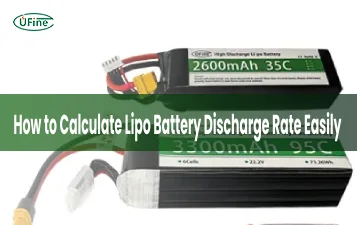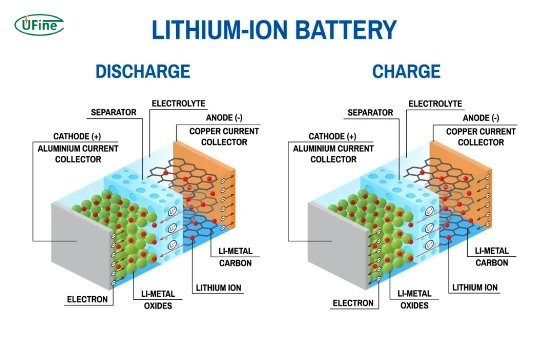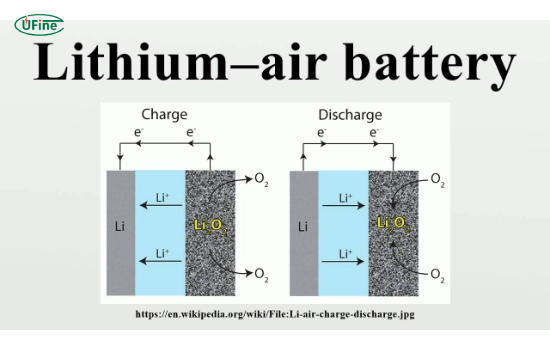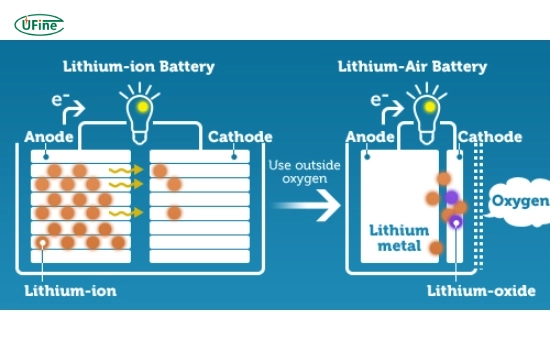Lithium-ion batteries have been the dominant player in energy storage technologies for several years. However, the emergence of lithium-air batteries has sparked interest due to their potential advantages. This article will explore the differences between these battery technologies and their advantages, disadvantages, applications, and prospects.
Part 1. What are lithium-ion batteries?
Lithium-ion batteries are rechargeable batteries that use lithium ions as a primary component of their electrochemistry. They are widely used in consumer electronics, electric vehicles, and renewable energy storage systems.
How Do Lithium Ion Batteries Work?
Lithium-ion batteries operate on the principle of lithium ions moving from the anode to the cathode during discharge and back when charging. The key components include:
- Anode: Typically made of graphite, it stores lithium ions during charging.
- Cathode: Made of lithium metal oxide, it releases lithium ions during discharge.
- Electrolyte: A lithium salt dissolved in a solvent that allows lithium ions to move between the anode and cathode.
Advantages of Lithium Ion Batteries
- High Energy Density: Lithium-ion batteries have a high energy-to-weight ratio, making them ideal for portable devices and electric vehicles.
- Long Cycle Life: They can endure many charge and discharge cycles without significant degradation.
- Low Self-Discharge Rate: Lithium-ion batteries retain their charge well when not used.
- Wide Availability: Lithium-ion technology is well-established, and components are readily available, making it easier to manufacture and replace.
Disadvantages of Lithium Ion Batteries
- Cost: They can be more expensive to produce compared to other battery technologies.
- Thermal Runaway: Lithium-ion batteries can overheat and catch fire if damaged or improperly charged.
- Limited Lifespan: Over time, their capacity diminishes, primarily if not appropriately maintained.
- Resource Dependency: The production of lithium-ion batteries relies on extracting lithium, cobalt, and nickel, which can have environmental and ethical implications.
Part 2. What are lithium-air batteries?
Lithium-air batteries are a newer technology that utilizes oxygen from the air as a cathode reactant. This unique feature allows them to offer much higher energy densities than lithium-ion batteries.
How Do Lithium-Air Batteries Work?
In lithium-air batteries, lithium ions react with oxygen to produce lithium peroxide during discharge. The main components are:
- Anode: Similar to lithium-ion batteries, typically made of lithium metal.
- Cathode: Uses air oxygen, significantly reducing weight and increasing energy density.
- Electrolyte: A conductive medium that facilitates the movement of lithium ions.
Advantages of Lithium-Air Batteries
- Extremely High Energy Density: Lithium-air batteries can theoretically achieve energy densities up to 10 times greater than lithium-ion batteries.
- Lightweight: Using air as a reactant reduces the battery’s overall weight, making it ideal for applications where weight is critical.
- Potentially Lower Cost: With abundant materials like oxygen, production costs may be lower in the long run.
- Environmental Impact: Using air as a reactant could reduce the ecological footprint in resource extraction.
Disadvantages of Lithium-Air Batteries
- Limited Cycle Life: Current lithium-air batteries have a shorter lifespan due to the lithium peroxide formed during discharge instability.
- Complexity: The technology is still experimental, making it less practical for widespread use.
- Environmental Sensitivity: Performance can be significantly affected by humidity and other environmental factors, which can hinder their reliability.
- Efficiency Challenges: Lithium-air batteries’ energy conversion efficiency needs to be higher than lithium-ion batteries, making them less practical for immediate use.
Part 3. Lithium-air vs. lithium-ion: energy density comparison
One of the most significant differences between lithium-ion and lithium-air batteries is their energy density.
| Battery Type | Energy Density (Wh/kg) |
| Lithium-Ion | 150-250 |
| Lithium-Air | 500-1000 (theoretical) |
Lithium-air batteries have the potential to provide much higher energy density, which could lead to longer-lasting power sources for electric vehicles and other applications. This characteristic particularly appeals to industries aiming for greater efficiency and reduced weight.
Part 4. Applications of lithium-ion and lithium-air batteries
Lithium Ion Battery Applications
- Consumer Electronics: Lithium-ion batteries are used extensively in smartphones, laptops, and tablets because of their compact size and efficiency.
- Electric Vehicles (EVs): Most electric cars use lithium-ion batteries due to their high energy density and longevity.
- Renewable Energy Storage: They are used in solar and wind energy systems to store excess energy for later use.
- Power Tools: Lithium-ion batteries are commonly found in cordless power tools due to their lightweight and high energy output.
Lithium Air Battery Applications
While still largely experimental, lithium-air batteries could find applications in:
- Electric Vehicles: If the technology matures, lithium-air batteries could provide longer ranges for EVs, addressing one of the major concerns of current battery technology.
- Aviation: Their lightweight and high energy density could revolutionize battery use in aircraft, potentially leading to more efficient and longer flights.
- Grid Energy Storage: They could store large amounts of energy generated from renewable sources, helping stabilize the grid and reduce reliance on fossil fuels.
- Military Applications: The high energy density of lithium-air batteries could be advantageous for military equipment, where weight and efficiency are critical.
Part 5. Prospects of lithium-ion and lithium-air batteries
Future of Lithium Ion Batteries
Lithium-ion technology is still evolving. Researchers are working on ways to increase energy density, lower costs, and make batteries safer. Innovations like solid-state batteries and new materials for anodes and cathodes are being explored. Companies are also investing in recycling to recover valuable materials from used lithium-ion batteries, which helps reduce environmental impact.
Future of Lithium-Air Batteries
The future of lithium-air batteries is promising but faces several challenges. Research is focused on:
- Improving Cycle Life: Focus on developing stable materials that can handle many charge and discharge cycles without wearing out.
- Environmental Adaptability: Work on creating batteries that work well in different conditions, like changes in humidity and temperature.
- Commercial Viability: Make the technology practical for mass production and everyday use by solving efficiency and cost problems.
- Integration with Renewable Energy: Look into how lithium-air batteries can be used in renewable energy systems to provide reliable storage.
Part 6. FAQs
-
What is the main difference between lithium-ion and lithium-air batteries?
The main difference lies in their chemistry; lithium-ion batteries use lithium ions between the anode and cathode, while lithium-air batteries utilize oxygen from the air, potentially offering higher energy density. -
Are lithium-air batteries commercially available?
Lithium-air batteries are still in the research phase and, due to technical challenges, have yet to be commercially available. -
Which battery type is safer?
Lithium-ion batteries have established safety protocols but can be prone to thermal runaway. Lithium-air batteries are less tested, and their safety is still under investigation. -
Can lithium-air batteries be used in electric vehicles?
Lithium-air batteries offer longer ranges for electric vehicles if the technology matures and overcomes current limitations. -
What are the environmental impacts of these batteries?
Both battery types have environmental concerns, including resource extraction and disposal at the end of their life. Lithium-air batteries might have a lower impact because they use common materials like oxygen. However, extracting lithium and other metals for lithium-ion batteries poses environmental challenges. These challenges are being addressed through recycling and sustainable sourcing practices.
Related Tags:
More Articles

LiPo Battery Discharge Rate Guide & Calculation Tips
Understand LiPo battery discharge rates, C-ratings, and how to calculate max current. Essential guide for RC, drones, and electronics users.
High‑Capacity 3S LiPo Batteries: 5000 mAh vs. 10000 mAh
Compare 3S LiPo 5000mAh vs 10000mAh batteries by weight, power, and use. Find the best fit for your drone, RC car, or boat setup.
Top 5 Applications for Small 3S LiPo Batteries
Small 3S LiPo batteries power drones, RC gear, wearables, and robotics with high energy and low weight. Making them ideal for compact electronics projects.
Building and Charging Your Own 3S LiPo Pack: A Step‑by‑Step Guide
Learn how to build, balance, and charge a 3S LiPo battery pack safely at home with this complete DIY guide for hobbyists and beginners.
How to Choose the Right LiPo Battery Plug Type?
Discover the best LiPo battery plug types, how to choose them, and expert tips for safe usage, soldering, and maintenance.






